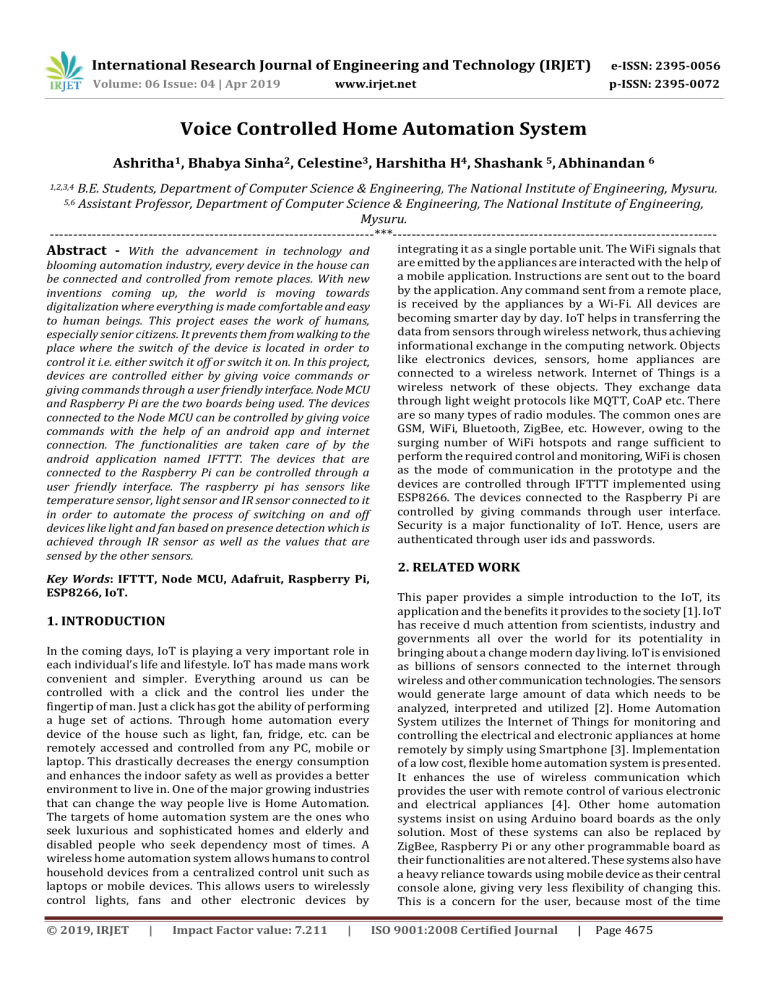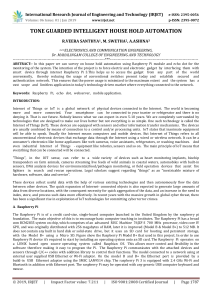IRJET- Voice Controlled Home Automation System
advertisement

International Research Journal of Engineering and Technology (IRJET) e-ISSN: 2395-0056 Volume: 06 Issue: 04 | Apr 2019 p-ISSN: 2395-0072 www.irjet.net Voice Controlled Home Automation System Ashritha1, Bhabya Sinha2, Celestine3, Harshitha H4, Shashank 5, Abhinandan 6 B.E. Students, Department of Computer Science & Engineering, The National Institute of Engineering, Mysuru. Assistant Professor, Department of Computer Science & Engineering, The National Institute of Engineering, Mysuru. ---------------------------------------------------------------------***--------------------------------------------------------------------- 1,2,3,4 5,6 Abstract - With the advancement in technology and blooming automation industry, every device in the house can be connected and controlled from remote places. With new inventions coming up, the world is moving towards digitalization where everything is made comfortable and easy to human beings. This project eases the work of humans, especially senior citizens. It prevents them from walking to the place where the switch of the device is located in order to control it i.e. either switch it off or switch it on. In this project, devices are controlled either by giving voice commands or giving commands through a user friendly interface. Node MCU and Raspberry Pi are the two boards being used. The devices connected to the Node MCU can be controlled by giving voice commands with the help of an android app and internet connection. The functionalities are taken care of by the android application named IFTTT. The devices that are connected to the Raspberry Pi can be controlled through a user friendly interface. The raspberry pi has sensors like temperature sensor, light sensor and IR sensor connected to it in order to automate the process of switching on and off devices like light and fan based on presence detection which is achieved through IR sensor as well as the values that are sensed by the other sensors. Key Words: IFTTT, Node MCU, Adafruit, Raspberry Pi, ESP8266, IoT. 1. INTRODUCTION In the coming days, IoT is playing a very important role in each individual’s life and lifestyle. IoT has made mans work convenient and simpler. Everything around us can be controlled with a click and the control lies under the fingertip of man. Just a click has got the ability of performing a huge set of actions. Through home automation every device of the house such as light, fan, fridge, etc. can be remotely accessed and controlled from any PC, mobile or laptop. This drastically decreases the energy consumption and enhances the indoor safety as well as provides a better environment to live in. One of the major growing industries that can change the way people live is Home Automation. The targets of home automation system are the ones who seek luxurious and sophisticated homes and elderly and disabled people who seek dependency most of times. A wireless home automation system allows humans to control household devices from a centralized control unit such as laptops or mobile devices. This allows users to wirelessly control lights, fans and other electronic devices by © 2019, IRJET | Impact Factor value: 7.211 | integrating it as a single portable unit. The WiFi signals that are emitted by the appliances are interacted with the help of a mobile application. Instructions are sent out to the board by the application. Any command sent from a remote place, is received by the appliances by a Wi-Fi. All devices are becoming smarter day by day. IoT helps in transferring the data from sensors through wireless network, thus achieving informational exchange in the computing network. Objects like electronics devices, sensors, home appliances are connected to a wireless network. Internet of Things is a wireless network of these objects. They exchange data through light weight protocols like MQTT, CoAP etc. There are so many types of radio modules. The common ones are GSM, WiFi, Bluetooth, ZigBee, etc. However, owing to the surging number of WiFi hotspots and range sufficient to perform the required control and monitoring, WiFi is chosen as the mode of communication in the prototype and the devices are controlled through IFTTT implemented using ESP8266. The devices connected to the Raspberry Pi are controlled by giving commands through user interface. Security is a major functionality of IoT. Hence, users are authenticated through user ids and passwords. 2. RELATED WORK This paper provides a simple introduction to the IoT, its application and the benefits it provides to the society [1]. IoT has receive d much attention from scientists, industry and governments all over the world for its potentiality in bringing about a change modern day living. IoT is envisioned as billions of sensors connected to the internet through wireless and other communication technologies. The sensors would generate large amount of data which needs to be analyzed, interpreted and utilized [2]. Home Automation System utilizes the Internet of Things for monitoring and controlling the electrical and electronic appliances at home remotely by simply using Smartphone [3]. Implementation of a low cost, flexible home automation system is presented. It enhances the use of wireless communication which provides the user with remote control of various electronic and electrical appliances [4]. Other home automation systems insist on using Arduino board boards as the only solution. Most of these systems can also be replaced by ZigBee, Raspberry Pi or any other programmable board as their functionalities are not altered. These systems also have a heavy reliance towards using mobile device as their central console alone, giving very less flexibility of changing this. This is a concern for the user, because most of the time ISO 9001:2008 Certified Journal | Page 4675 International Research Journal of Engineering and Technology (IRJET) e-ISSN: 2395-0056 Volume: 06 Issue: 04 | Apr 2019 p-ISSN: 2395-0072 www.irjet.net mobile devices are carried along with the user everywhere they go rather than statically staying in the house. They also do not support voice commands from the user [5]. Most of the other home automation systems use Bluetooth in their mobile device for implementation. This has various demerits in every aspect. Primarily the Bluetooth has a very small range and the proposed system could only work in small homes, excluding homes with larger area. Bluetooth does not support remote operations, (i.e.) the appliances cannot be controlled by Bluetooth from a remote geographical. Many appliances within the same range may pick up the commands given to particular device resulting in erroneous behavior [6]. The purpose of this paper [7] is to use a mobile app to control electronic devices. It is also useful to save electricity and determine the cost of electricity that is used in each device so that the optimization can be achieved. In this [8] paper, monitoring and remote control of domestic equipment based on IoT from an Android application using Raspberry pi card is possible. The main objective here is to automate all the devices i.e. home appliances through internet using Raspberry Pi, as well as we can have the security for the system by using sensors like PIR, LPG, temperature sensors. By this effective technique use of our renewable energy resources utilization is done in great extent. This paper [9] deals with the automatic control of lights or any other home appliances using internet. The proposed work is conceived in networking our mobile to various appliances via a smart logic circuit. It consists of Smart Logic Circuit connected to the appliances. Status of all home appliances can be controlled by users from remote areas with help of user’s mobile phone. The various system functions supported are temperature and humidity, gas leakage detection, control appliances. The designed system in addition to monitoring the sensor data, like temperature, gas, light, motion sensors, but also actuates a process according to the requirement , for example switching on the light when it gets dark. It also stores the sensor parameters in the webpage (database) in a time specific manner. This will help the user to analyze the condition of various parameters in the home anytime anyplace. 3. EXISTING SYSTEM High cost of ownership, inflexibility, poor manageability, and difficulty in achieving security are the main challenges home automation systems face. The existing smart home systems that have either been implemented or proposed have an elaborate procedure to interact with the home appliances. Some include pressing a button in a static location while some others include giving commands through a mobile device. One of the main drawbacks of the existing home automation systems is range. Most of the existing home automation systems have been implemented using technologies like Zigbee, Bluetooth, etc. These restrict the usage of applications within a certain range. Another drawback that exists with few applications is that the users © 2019, IRJET | Impact Factor value: 7.211 | are forced to use the commands in a pre-defined way. This restricts the flexibility of the user. 4. PROPOSED SYSTEM This project aims to provide an easy and efficient way to interact with home appliances by giving voice commands in human language. The appliances are connected to the mobile device through a Raspberry Pi or Node MCU that establishes the concept of Internet of Things. The Raspberry Pi and Node MCU are interfaced with the appliances and programmed in such a way that they respond to mobile inputs. Our project automates the operation of every single appliance in the house, which greatly reduces the power consumption due to excess use/wastage of the appliance services. It also reduces the effort put by human beings to a great extent. The proposed system has a great flexibility by using Wi-Fi technology to interconnect its distributed sensors to home automation server. This decreases the deployment cost and increases the ability of system reconfiguration and upgradation. Also flexibility is increased by giving users an option to specify the commands according to their comfort and also in the language they prefer. Automatic switching on and off certain appliances such as lights and fan happen by identifying the presence of human beings as well as by identifying the environmental conditions through sensors. This system satisfies the users to a better extent by enabling them to operate their devices using specific, personalized operations pertaining to devices of the user’s choice. 5. IMPLEMENTATION 5.1 System Parts 1) Node MCU: Node MCU is an open source IoT platform. It includes hardware which is based on the ESP-12 module and firmware which runs on the ESP8266 Wi-Fi SoC. 2) Raspberry Pi: It is a low cost, small sized computer with the capability of doing everything that a desktop computer could do. It consists of a processor and hosts a Linux Operating System named Raspbian Jessie which is made to suit the needs of IoT. 3) PIR Sensor: A PIR (Passive InfraRed) sensor is a motion detector which detects the heat (infrared) emitted naturally by humans and animals. Whenever a person in the field of vision of the sensor moves, it detects a sudden change in infrared energy and the sensor gets activated. 4) Relay Module: A relay is a switch which is operated electrically. Relays are used whenever it is necessary to control a circuit via a separate low-power signal, or where multiple circuits are controlled by one signal. ISO 9001:2008 Certified Journal | Page 4676 International Research Journal of Engineering and Technology (IRJET) e-ISSN: 2395-0056 Volume: 06 Issue: 04 | Apr 2019 p-ISSN: 2395-0072 www.irjet.net 5) Ultrasonic Sensor: An Ultrasonic sensor is a device that measures the distance from an object with the help of sound waves. 6) Web Server: Web server is a program that uses HTTP to serve files that create web pages to users in response to their requests, which are forwarded by their computer’s HTTP connection. 7) IFTTT: If This Then That, also known as IFTTT is an open source web-based service to create chains of simple conditional statements, called applets. 8) Adafruit IO: Adafruit IO is a system that allow simple data connections with little programming .IO includes client libraries that wrap our REST and MQTT APIs.IO is built on Ruby on Rails, and Node.js. 9) Google Assistant: Google Assistant is an artificial intelligence powered assistant developed by Google and is available on mobile and smart home devices primarily. Google Assistant can engage in two-way conversations. 5.2 System Architecture and Working Voice Controlled Home Automation implemented in two modules. System Fig 1: Architecture of Raspberry Pi WORKING OF MODULE 1: Once the system is switched on and the user logged in, Raspberry Pi 3 communicates to cloud via client server model. Client opens the web page and requests for the server by entering valid IP address of the web page into the address bar. Appliances connected to the system are automatically controlled based on the values detected via sensors connected to the system but otherwise can also be controlled via control buttons present in the web page. Module 2: Fig 2 shows the implementation using node MCU which will enable voice-based automation. Adafruit IO is used to set up the dashboard for our application and to provide MQTT Broker Service. MQTT is a lightweight protocol that allows multiple devices to connect to a shared server, called the MQTT Broker, and subscribe or write to user defined topics. The broker will send a notification to the device whenever that topic changes if a device is subscribed to it. Dashboards will let you directly manipulate or view the current value of each topic. is Module 1: Fig 1 shows the implementation using Raspberry Pi which will add web-based GUI capacity to our system. A web page is developed to run the light control, fan control, door sensor and LDR sensor control. This page will be created to run on devices such as smartphones, pc or laptops which are connected to the internet. The block diagram of the design is shown in figure 1. The Raspberry Pi 3 serves as a client which is interfaced with a motion sensor and a relay. Its purpose is to serve as the control unit running on a python program. It runs on a Raspbian Operating System (OS). Fig 2: Architecture of Node MCU The initial setup required is creation of an Adafruit account, dashboards and feeds in the account, and including libraries in the program. Once the initial setup is done, connection has to be established between IFTTT, Adafruit and Google Assistant. WORKING OF MODULE 2: You speak your command via Google Assistant enabled device. Google voice services transcript it and search the different providers for one that can handle it, including IFTTT. IFTTT grabs the command and tells GA “yeah, I can do that”. IFTTT translates it again based on an applet you have © 2019, IRJET | Impact Factor value: 7.211 | ISO 9001:2008 Certified Journal | Page 4677 International Research Journal of Engineering and Technology (IRJET) e-ISSN: 2395-0056 Volume: 06 Issue: 04 | Apr 2019 p-ISSN: 2395-0072 www.irjet.net defined. The action in applet instructs IFTTT to tell Adafruit IO to complete a request. Adafruit IO performs the request to an address that points to the connected device. Your device executes the action. alerting in ways not possible before. In order to address the issues of flexibility and functionality, a novel, standalone, flexible and low-cost home controlling and monitoring system using Web services as an interoperable layer for communicating between the remotely present user and the home devices, have been designed. Performed research have shown that by using the Raspberry Pi and open source software it is possible to programmatically control many devices in a home in such a way that user can create his/her own solution customized to meet his/her individual needs. Thus, the proposed system is better from the scalability, flexibility and security point of view than the commercially available home automation. Advantages: This proposed system provides many advantages including, Safety, Security, Improved comfort, Energy and Cost savings. The system also has better scalability and flexibility. 7. FUTURE ENHANCEMENT Fig 3: Workflow Diagram 6. CONCLUSION The home automation which utilizes IOT has been proven to work well in conjunction with various appliances. The appliances were with success controlled remotely through internet. The designed system in addition to monitoring the sensor data, like temperature, gas, light, motion sensors, also actuates a method as per the need, for example switching on the lights when it gets dark. It also stores the sensor parameters in the cloud in a very timely manner. This will facilitate the user to investigate the condition of a variety of parameters within the home anytime anyplace. The code provided is generic and versatile in a very user-friendly manner and might be extended for any future applications like power management, surveillance, etc., easily. Moreover, this technique is better than other home automation methods is several ways. The application of the IoT technology, in home automation means combination of all electrical devices like smart mobile phone, personal computer, tablet and their monitoring, controlling and © 2019, IRJET | Impact Factor value: 7.211 | Additional features that can be added to this project are as follows: The application associated with the raspberry pi module can be modified to send notifications to the user whenever there is a change in state of the appliance. The user can be given the option of setting the threshold value associated with temperature. When the real time temperature that is sensed by the sensors goes below the threshold value set by the user, the fan should switch off and when the sensor values goes above the threshold value, the fan should switch on. Identified users voices can be used for operations like opening the main door, thus preventing acts like thefts and burglary attacks which increases the security. Acknowledgement mechanism can be added so that the user can get to know if the intended operation has taken place or not. The website can be upgraded to an app which will facilitate more features and more user friendly. ACKNOWLEDGMENT The authors would like to thank the Principal, Dr. G Ravi, The head of the department of Computer science and Engineering, Dr. H D Phaneendra and the faculty of The National Institute of Engineering, Mysuru for providing insight and expertise that greatly assisted the project. REFERENCES [1] D. Norris , The Internet of Things : Do - It - Yourself at Home Projects for Arduino , Raspberry Pi and BeagleBone Black . Tab Electronics , 2015. ISO 9001:2008 Certified Journal | Page 4678 [2] [3] [4] [5] [6] [7] [8] [9] International Research Journal of Engineering and Technology (IRJET) e-ISSN: 2395-0056 Volume: 06 Issue: 04 | Apr 2019 p-ISSN: 2395-0072 www.irjet.net D. Giusto , A. Iera , G. Morabito, and L. Atzori , The Internet of Things . New York , NY : Springer New York , 2010. Raspberry pi as a sensor Web node for home automation Vladimir Vujovic , Mirjana Maksimovic http://dx.doi.org/10.1016/j. compeleceng .2015.01 .019K. Elissa, “Title of paper if known,” unpublished. A. Z. Alkar and U. Buhur , “ An internet based wireless home automation system for multifunctional devices,” IEEE Trans . Consum. Electron ., vol. 51, no. 4, pp. 1169– 1174, Nov . 2005. Nathan David , Abafor Chima, Aronu Ugochukwu , “ Design of a Home Automation System Using Arduino ”, International Journal of Scientific & Engineering Research, Volume 6, Issue 6, June-2015. Akbar Satria, Muhammad Luthfi Priadi, Lili Ayu Wulandhari, Widodo Budiharto , “ The Framework of Home Remote Automation System Based on Smartphone”, International Journal of the Smart Home Vol . 9, No . 1 (2015). Akbar Satria, Muhammad Luthfi Priadi, Lili Ayu Wulandhari and Widodo Budiharto , The framework of home automation system based on smartphone, 2015. Dipali D. Ghorpade , Anjali M.Patki, IoT based smart home automation using renewable energy sources, 2016. Pooja patel, Mitesh patel, Vishwa panchal, Vinit Nirmal , Home automation using Internet of Things , 2016. © 2019, IRJET | Impact Factor value: 7.211 | ISO 9001:2008 Certified Journal | Page 4679




